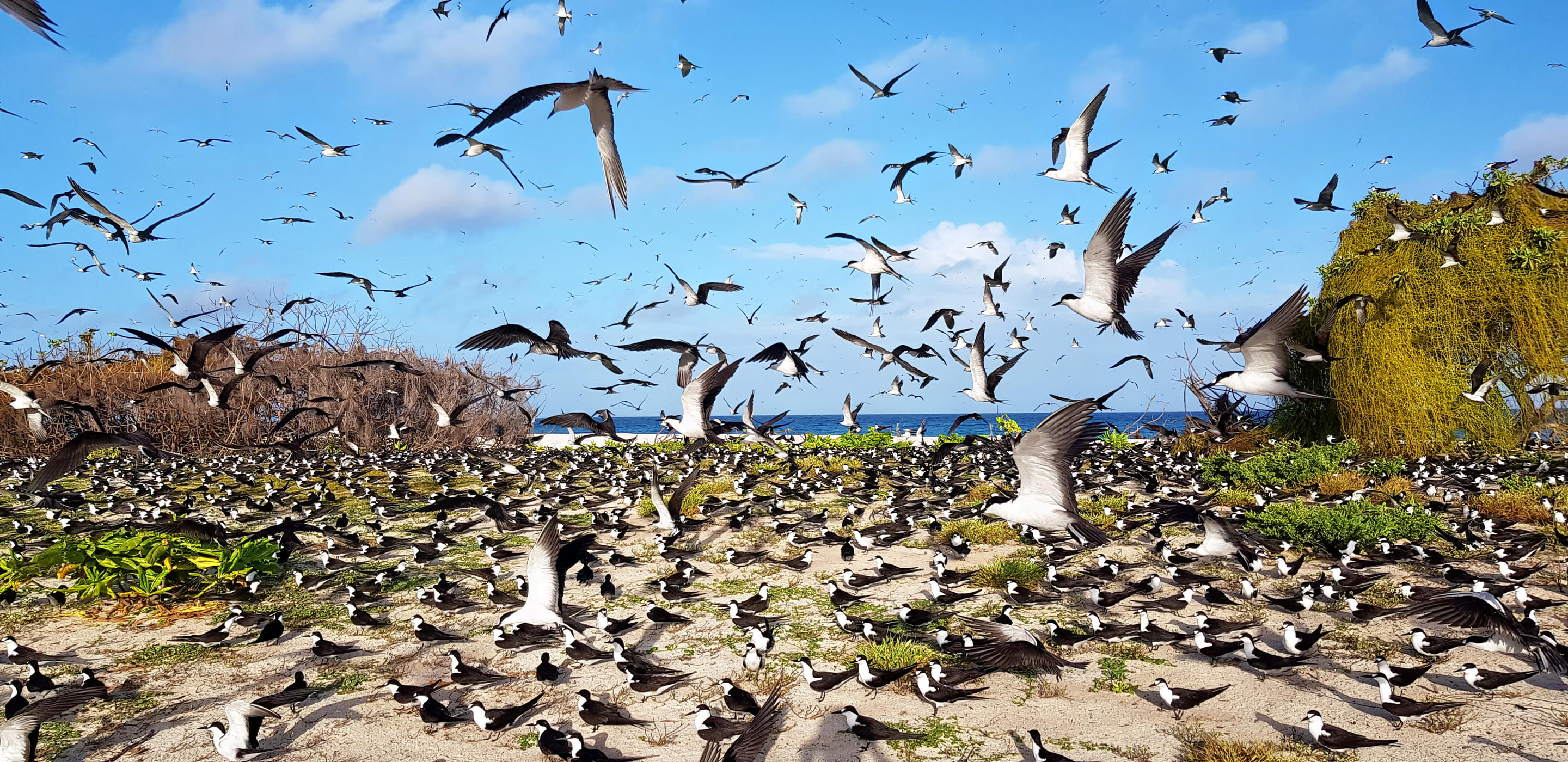About Bird Island
Later in 1967 Bird Island was privately owned and in the early 19070s, it turned into a booming eco-tourism hub of Seychelles with several conservation programs for protecting the endangered species of birds and animals. The name Bird Island has been coined in the honour of the spectacular colony of around 70,000 pairs of Sooty Tern that have made the island their habitat. During the months of May-September when southeast trade winds flow across the region more than a million Sooty Terns lay eggs in their territory.
It is also a peaceful habitat of Fairy Terns, white-tailed tropic birds, fodies, whimbrels, and plovers, making it a must-visit destination for travelers exploring Seychelles tour packages. Another phenomenal occurrence you can see on Bird Island is the first landfall of migratory Eurasian birds along the northern border of Seychelles Bank during the months of October to December. The water expanse of Bird Island is home to rich and exotic marine life, including Green and Hawksbill Turtles, dolphins, whales, and colorful fishes, adding to the allure of Seychelles tour packages for nature enthusiasts.
The island fairly boasts of housing the world's heaviest land tortoise weighing over 300 kg and known to be more than 200 years old. Bird Island is now a high-class tourist destination with 24 luxurious bungalows, stunning beaches, food joints and a relaxing ambiance for adventure activities. It also has a small weather station and a small runway in Bird Island Airport which connects the island with mainland Mahe.
How To Reach Bird Island
Located at a distance of about 105 kilometres from Mahe, the only way to reach Bird’s Island is by air. There is regular charter service by Air Seychelles which drops you at Bird’s Island in just 30 minutes.
There are direct flights from London and layover flights from other major airports of the UK which reach the International Airport of Seychelles at Mahe in 9-14 hours. Regular scheduled flights ply between Mahe and major cities of Asia, Africa, Europe and Middle East.
Best Time To Visit Bird Island
For a keen bird watcher, the best time to visit Bird’s Island is in March to May and October to November. This is the time when migratory birds fly down from the polar regions to the warm tropical island and you can get to see various species of birds in the island. The months between October-February is the time when you can spot Hawksbill Turtles on the beach that come ashore to lay eggs.
During this time of the year the night sky in particular remains spotlessly clear in Bird’s Island where there is no light pollution. As a result, you can enjoy viewing the constellations in the Southern Hemisphere. The months between October-April is also the best time for snorkelling as the sea remains calmer and clearers due to the influence of the northeast trade winds.
Bird Island Other Essential Information
History of Bird Island
The island was first spotted in a year 1771 by a passing master cruiser ‘The Eagle’ who said the following words about the island:
“Birds Innumerable and many sea cows (dugongs) on the beach.”
The name of Bird Island was thus coined. Initially the island was mined for guano (bird droppings) but later in the years between (1896-1906) about 17000 tons of guano were removed and exported to the sugarcane plantations of Mauritius. Coconut and cotton plantations were set up along with cash crops such as papaya, sea cabbage and nutgrass. Later, in 1967 the island was bought by its current owners who have tried to capitalize on the conservation of the island’s natural resources and initiate tourism business in parallel. As one of the world’s first eco-tourism ventures the program was successful in both fields- conservation and tourism.
In 1997, Bird island was visited by noted broadcaster and historian Sir David Attenborough and his crew for the two episodes of his film The Life of Birds. In the year 2006, Bird Island won the accolade of 7th best destination for the purpose of ecotourism as per BBC Wildlife Magazine.
Flora and Fauna at Bird Island
1. Coastline Vegetation: Along the extensive shoreline of Bird Island you will find Veloutier, Bwa d'amande and bwa tabac plants.
2. Central Parkland and Core Forest Area: The island retains some of its original coconut plantations. Other species of plants include Mapou, Beach Cabbage and Casuarina trees.
3. Other Plants: Some of the indigenous variety of plants include the Indian Nettle, Citronelle, and Frangipani, crops such as tomatoes, lettuce, papaya and pumpkin are grown in the farms.
4. Birds: This coralline island is a huge colony for birds ranging from the migratory to sea birds. The resident birds that are found in this region include Barred Ground Doves, Fairy Terns, Ruddy Turnstones, Curlew Sandpipers and Grey Plovers. Migratory birds that fly down to this tropical region are Black Winged Stilts, Bar-tailed Godwits, Little Tern and Crab Plovers. The local birds of the island are Red Backed Shrike, Blue -cheeked Bee-eater and others.
5. Tortoises: June to September is the time when numerous Green turtles are spotted who migrate long distance to lay eggs in their nesting beaches. Another critically endangered species of tortoises is the Hawksbill Turtles that come out of the sea between October and February to lay eggs on the beach.
6. Marine Life: You will get to see Bottlenose Dolphins and Spinner Dolphins frolicking in the sea waters if you go for a boat ride. If you are lucky you may spot Humpback Whales, Short-Finned Pilot Whales and Southern Right Whales in this region.












